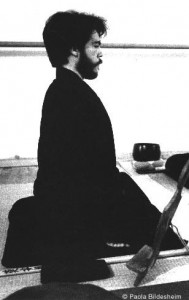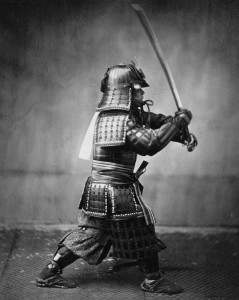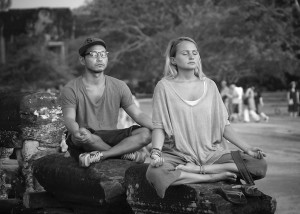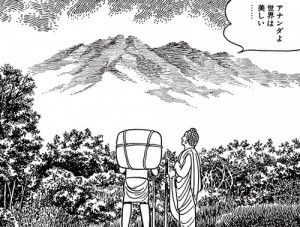 Michele cut an impressive and striking figure, having a thick shock of jet-black hair and a warrior’s beard. He was particularly impressive when sitting, chest-hoisted on his cushion in zazen-meditation, droopy-sleeved Koromo robes gathered around him. In this way, he resembled nothing less than the epitome of spiritual ardency.
Michele cut an impressive and striking figure, having a thick shock of jet-black hair and a warrior’s beard. He was particularly impressive when sitting, chest-hoisted on his cushion in zazen-meditation, droopy-sleeved Koromo robes gathered around him. In this way, he resembled nothing less than the epitome of spiritual ardency.
Zen as a spiritual discipline has a particular flavour, somewhat different to other Buddhist strains. They all originated of course in India, when the Buddha held up a flower to transmit the wordless essence of the dharma to his disciple Mahākāśyapa, dharma roughly translatable here as “the laws of the universe”. But dharma, like a flower could also be woven into your hair or put in a vase on your desk, inhabiting a more personal space in your life, as a kind of practical code for living, a code we now might call psychology.
 After the flower power sermon the Buddha’s life codes travelled via itinerant monks through China and into Japan where they brushed up against another code, that of Bushido, the way of the warrior, in this case the Samurai warrior. This later became the prescription for Zen: a flower-loving, slightly belligerent, neo-Confucian mongrel, which like its Samurai progenitors fetishized righteousness, courage, benevolence, respect, sincerity, honour, loyalty self-control, but also paradoxically spontaneity, with a transcendental twist.
After the flower power sermon the Buddha’s life codes travelled via itinerant monks through China and into Japan where they brushed up against another code, that of Bushido, the way of the warrior, in this case the Samurai warrior. This later became the prescription for Zen: a flower-loving, slightly belligerent, neo-Confucian mongrel, which like its Samurai progenitors fetishized righteousness, courage, benevolence, respect, sincerity, honour, loyalty self-control, but also paradoxically spontaneity, with a transcendental twist.
The twist came not through words or hacking the arms and legs off one’s enemies, but rather via an inwardly-focused experience, which somehow managed to circumvent rational thought and understanding, travelling directly into one’s so-called “true nature”, one’s “Buddha-nature”, one’s soul. Michele looked like a man who was well on his way to achieving this soul-confab.
Silvia was blonde, somewhat thickset, but attractive. She was also, I later came to discover,Michele’’s girlfriend. They had met at an Aikido class, the non-killing division of the Samurai’s legacy. In fact most of the Zen group were offshoots of this class. Perhaps Dario had sold them on the Zen-improved ratio of 4:1 sitting versus jumping around. In Aikido, this ratio was reversed. Those to whom the more sedentary practice appealed, seem to have all followed him to Piazza Dante.
 Michele did such a good job of projecting the disciplined, ascetic, highly magisterial ethos of Zen that I couldn’t even begin to imagine what he and Silvia got up to when they were by themselves. Surely not the things that other couples in their mid-20s did such as going to the cinema, holding hands, slobbing out in front of the telly, picnics, or experimenting with sexual positions. Indeed, where did sex factor into their equation if everything was the equivalent of a philosophy symposium?
Michele did such a good job of projecting the disciplined, ascetic, highly magisterial ethos of Zen that I couldn’t even begin to imagine what he and Silvia got up to when they were by themselves. Surely not the things that other couples in their mid-20s did such as going to the cinema, holding hands, slobbing out in front of the telly, picnics, or experimenting with sexual positions. Indeed, where did sex factor into their equation if everything was the equivalent of a philosophy symposium?
Then there was Massimo: middle-aged, balding, unassuming, not as ardently gung-ho about the practice as Michele, but no less committed. Massimo was to Michele’s lean mean meditating Buddha-machine a kind Ananda.

“Yes, dear Master.”
Ananda is the Buddha’s most famous disciple, his right-hand monk. In the Buddhist sutras, a combo how-to text with added mythologizing, Ananda and the Buddha have a similar relationship to Watson and Holmes. Watson is the foil for Holmes’s brilliance, a bright-enough but deferential student who hangs on the Master’s every word. Buddha and Ananda, Holmes and Watson: you can’t really have one without the other.
My most abiding memory of Massimo however is a conversation I had with him one day at the end of an evening’s sitting. The conversation had probably lasted for all of a minute. But it is to this brief exchange that I’ve been returning to intermittently over the past 20 years, and much more so recently.
 Massimo had been showing us his dog drawings: hundreds of small, indian ink images of his “bastardo”: a Chihuahua/Jack Russell hybrid called Chivas. I had wondered if this might be Mario’s favourite tipple. Michele I assumed was a teetotaller.
Massimo had been showing us his dog drawings: hundreds of small, indian ink images of his “bastardo”: a Chihuahua/Jack Russell hybrid called Chivas. I had wondered if this might be Mario’s favourite tipple. Michele I assumed was a teetotaller.
At one point Massimo said that he had learnt more about the true spirit of Zen from Chivas (I presumed he was still talking about his dog at this point) than all his years of daily meditation practice and week-long retreats. I remember Michele overhearing all of this and leaning over to interject a noise into the conversation that sounded a little bit like the sound a cow might make. Moo! (Later, I would understand that he hadn’t been saying Moo, but Mu. I’ll come back to this in due course.)
Massimo’s words stuck in my head. They stuck in the way a good Koan sticks.
 What is the sound of one hand clapping?
What is the sound of one hand clapping?
If a tree falls in a forest and no one is around to hear it, does it make a sound?
Why did the chicken cross the road?
Knock-knock.
Koans: those paradoxical riddles and philosophical thought experiments designed to shake us up, wake us up. Was Massimo positing a kind of koan for us that day, something like: could hanging out with a four-legged Canis lupus familiaris (literally: family dog-wolf) get us closer to enlightenment than all the months, years, or even lifetimes, if you believed in reincarnation, spent sitting in from of a brick wall watching dry paint dry further.
Was this true?
I’d have to wait 20 years to find out.